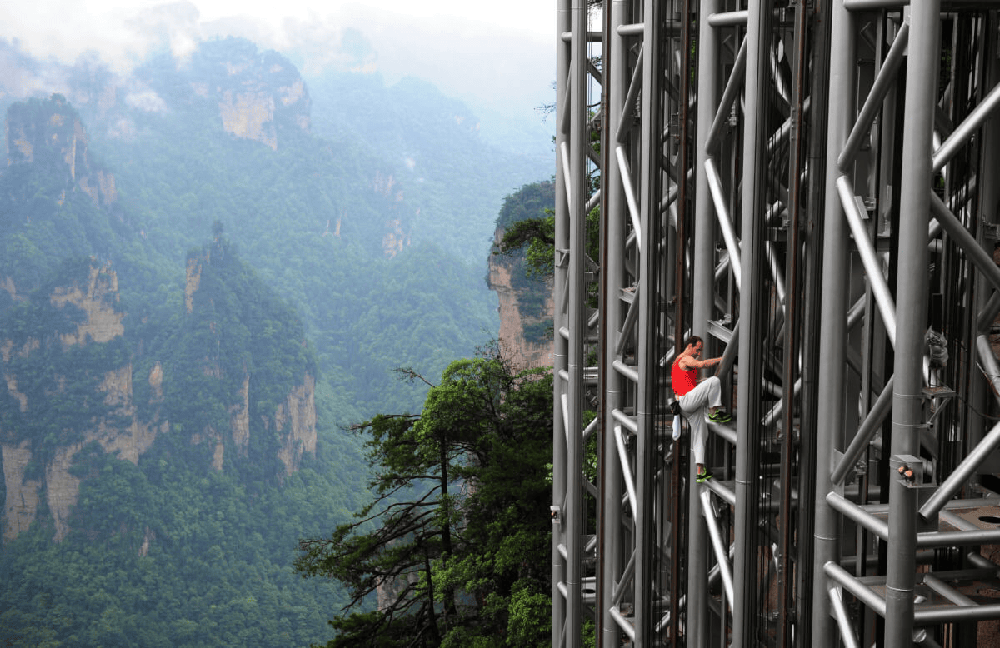Bailong Elevator: A Marvel of Engineering and Environmental Controversy

The Bailong Elevator, often referred to as the "Hundred Dragons Elevator," provides visitors with a truly extraordinary and unique experience. Recognized as the tallest outdoor lift in the world by Guinness World Records, it offers a breathtaking way to appreciate the natural beauty of the Wulingyuan area in China while also contributing to the local economy. This engineering marvel rises 326 meters up the side of a quartzite cliff, with the upper 171.4 meters of the structure above ground, allowing passengers to enjoy stunning views of the area's karst monolith rock formations.
Key Achievements
- Guinness World Record: The Bailong Elevator was officially honored in 2015 as the tallest outdoor elevator in the world.
- Passenger Capacity: Each elevator car can accommodate up to 50 people, transporting approximately 1,380 passengers per hour per car.
Construction and Challenges
Construction of the elevator began in 1999 and was completed in 2002 at an estimated cost of £12 million (120 million yuan). Building such a structure in a UNESCO World Heritage site was not without controversy. Environmentalists voiced concerns about the impact on an already heavily touristed area. Nevertheless, proponents argued that the elevator would help preserve the mountain trails by reducing the damage caused by foot traffic.
Technological Innovations
- Earthquake Detectors: The elevator cars are equipped with earthquake detectors, allowing for quick evacuation in case of seismic activity.
- Construction Materials: Lift shafts and tunnels were carved out of a specifically selected quartz sandstone column.
- Speed and Capacity: The elevator ascends at a rate of approximately 3 meters per second and can transport up to 4,000 people per hour if all three elevators are in operation.
Environmental Impact and Controversy
Despite significant opposition, Chinese authorities maintain that the Bailong Elevator has helped protect rather than harm the region. According to the Environmental Assessment, the elevator's completion aids in preserving the world heritage site. The demolition of numerous hotels and guesthouses has reduced the environmental strain during peak tourist seasons. By shortening travel time, the elevator eliminates the need for tourists to stay overnight, thereby lessening the overall environmental impact.
Visitor Experience
The Bailong Elevator allows tourists to experience the stunning natural scenery conveniently and thrillingly. Visitors can enjoy panoramic views from the fully glazed elevator cars, which enhance the sightseeing experience. This setup enables tourists to "go sightseeing up the mountain during the day and stay down the mountain at night," saving them from the strenuous alternative of hiking the mountain trails.
The Bailong Elevator project is a fascinating and impressive feat of engineering, blending innovation and functionality while also generating a fair share of controversy. Here are my thoughts:
 Engineering Marvel
Engineering Marvel
The Bailong Elevator, officially the tallest outdoor elevator in the world, is an extraordinary example of what modern engineering can achieve. The fact that it is hewn into the side of a quartzite cliff and rises 326 meters is remarkable. The elevator's ability to carry large numbers of passengers efficiently, combined with features such as earthquake detectors, highlights the advanced technological considerations that went into its design.
Tourist Attraction and Economic Boost
From a tourism perspective, the elevator offers a unique and thrilling experience, allowing visitors to enjoy breathtaking views of the Wulingyuan area. It provides a significant boost to the local economy by attracting a large number of tourists each year. The convenience of ascending the cliff in a minute and a half instead of a long hike is certainly appealing to many visitors.
Environmental and Heritage Concerns
The controversy surrounding the project stems from valid environmental concerns. Constructing such a massive structure in a UNESCO World Heritage site undoubtedly raises questions about the balance between tourism development and environmental preservation. The argument that the elevator helps protect mountain trails by reducing traffic is an interesting one, yet it does not fully mitigate the concerns about the potential impact on the delicate ecosystem and geological integrity of the area.
Aesthetic and Practical Considerations
Aesthetically, the elevator is a striking addition to the landscape. The fully glazed cars offering panoramic views enhance the visitor experience, making the ride not just a mode of transportation but an integral part of the sightseeing experience. Practically, the elevator has also led to the removal of many accommodations that previously contributed to environmental strain, which can be seen as a positive change.
In conclusion, the Bailong Elevator is a remarkable feat of engineering that, despite its controversial construction, offers an unparalleled visitor experience. It balances the demands of tourism, environmental preservation, and economic benefits, standing as an innovative solution in one of the world's most scenic areas. The debate surrounding its impact underscores the ongoing challenge of developing infrastructure that respects and preserves natural beauty while providing modern conveniences.




















